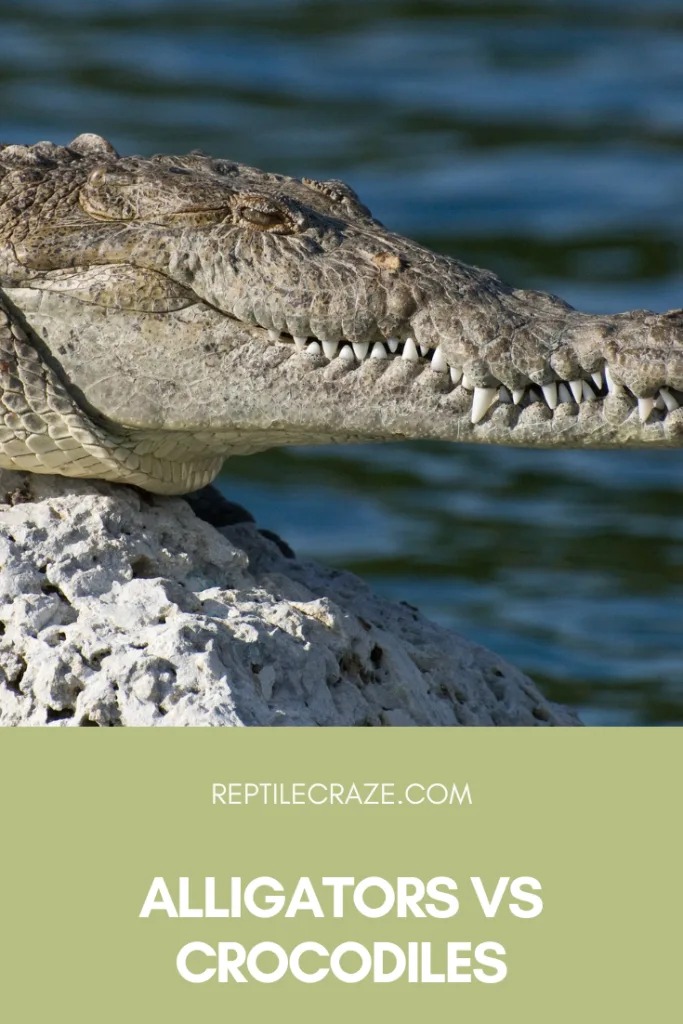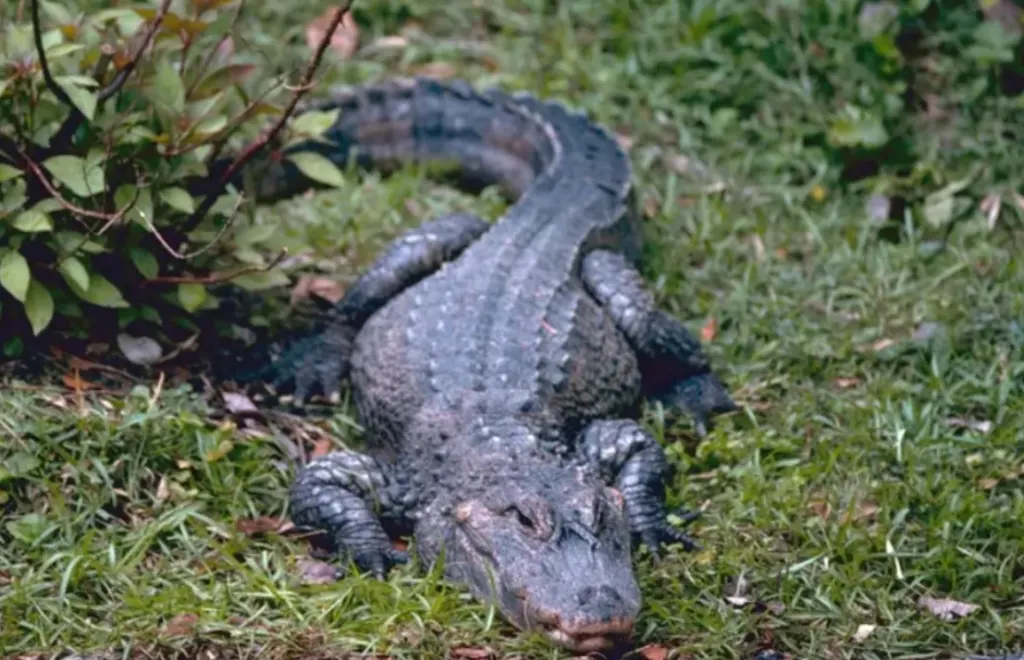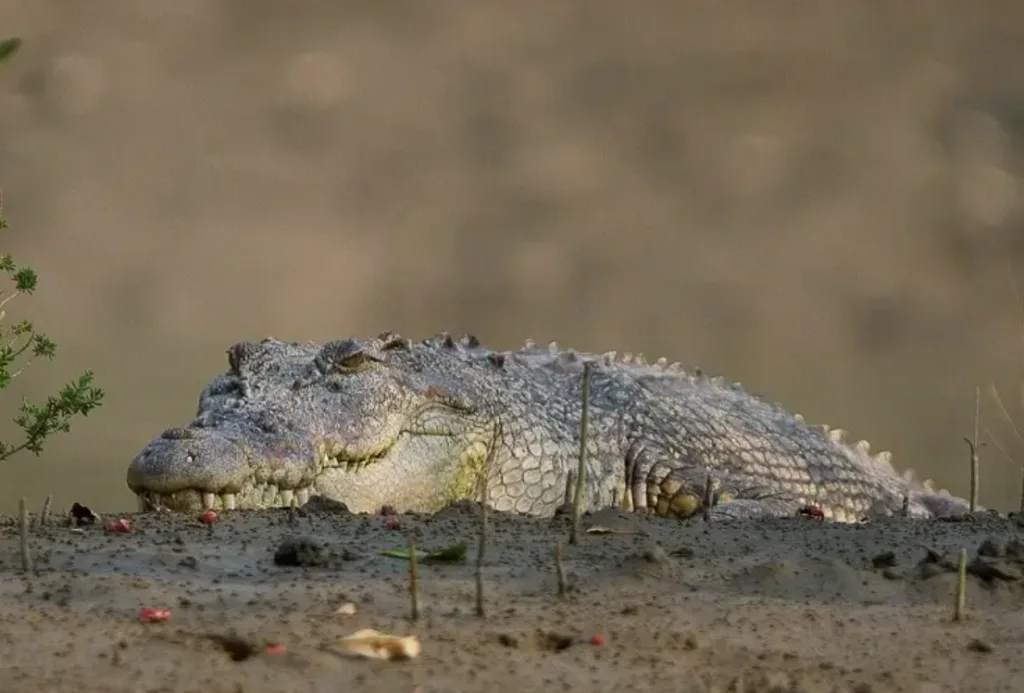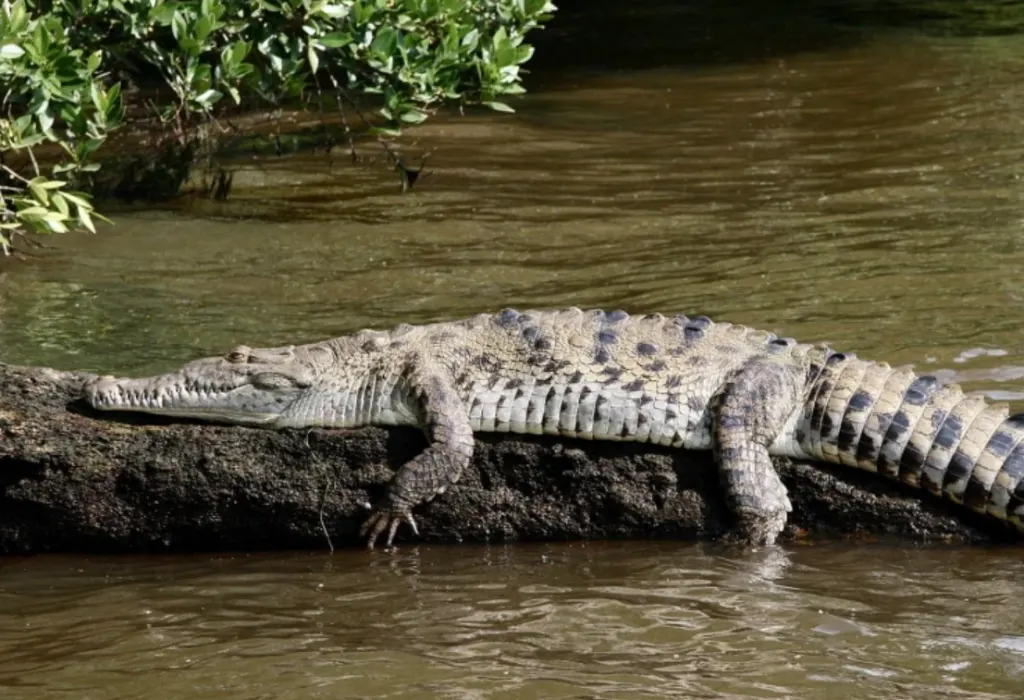You know when you’re watching a movie, and there’s that huge reptile lurking in the water, and you’re caught in the classic “alligator vs crocodile” debate? Let’s settle that score right now!

Table of Contents
Breaking Down the Differences
Alright, let’s get into the nitty-gritty:
- That Iconic Snout: First thing you’ll probably notice? Their snouts! Crocs sport that narrow, V-shaped one which isn’t just for looks. It’s pretty darn functional, making them super-efficient at snapping up a fish or two. Meanwhile, our gator buddies? They’re rocking the broader, U-shaped snout. Think of it like a built-in nutcracker, perfect for tackling harder treats, like turtles. It’s more than just face value with these guys!
- The Size Game: So here’s the tea on sizes: gators are chunky lads, for sure. But have you heard of the African Nile croc? This legend stretches to a whopping 20 feet. If you’re thinking that’s huge, brace yourself. The Australian Saltwater Crocodile isn’t one to be left behind, reaching lengths of up to 23 feet! Imagine six average-sized humans lined up head to toe—that’s one massive reptile.
- H2O Preferences: Our reptilian friends have got their preferences down pat. Crocs? They’re the adventurers, partial to salty waters and hanging by coastal vibes, giving off those beach bum energies. On the flip side, gators? They’re the freshwater enthusiasts. Think lazy rivers, serene swamps, and the iconic marshy expanses of the Florida Everglades. Two very different holiday spots!
- Footsie Play: Let’s stroll a bit lower—right down to their toes. Gators are the ultimate swimmers with webbed feet, kinda like nature’s flippers, which give them the upper hand in navigating those swamps. Crocs, though? They’ve got more distinct toes, no webbing drama. This makes them agile on varied terrains, from muddy riverbanks to sandy shores. Who knew foot fashion could be so functional?
Alligators in the Limelight
Let’s talk gators, shall we?

- American Alligators (Alligator mississippiensis): When you’re picturing the sunny, picturesque landscapes of Florida with its pristine beaches and sun-soaked palm trees, there’s another iconic resident you can’t forget – the American alligator. Historically, their numbers saw a major dip because of hunting and loss of their natural habitats. It was a rough patch, indeed. But here’s the cool part: thanks to rigorous conservation efforts and laws put into place to protect them, these alligators have bounced back. Not just surviving, but thriving. Nowadays, if you’re taking an airboat ride through the Florida Everglades, chances are, you’ll spot these majestic creatures sunning themselves or peeking out of the water with those unmistakable eyes.

- Chinese Alligators (Alligator sinensis): Taking you on a journey to the East now. The Chinese alligator is like the rare collectible of the alligator world. Native to the freshwater rivers and lakes of the Yangtze River basin, these guys have a distinct look with their upturned snouts and smaller stature. However, urbanization and changes in their natural habitats have painted a challenging picture for them. They’ve now landed themselves on the endangered list. It’s not all gloom and doom though. Conservation efforts are in full swing to ensure these unique alligators don’t just become a page in a history book.
Croc Chronicles
The fascinating tales of the world’s most infamous reptiles:

- Saltwater Crocodiles (Crocodylus porosus): These legends hail from the Down Under – Australia. With their daunting sizes, some stretching beyond 23 feet, they dominate their territories like royalty. But it’s not just their imposing presence that earns them respect. The Saltwater crocs possess a jaw-dropping bite force, unmatched in the animal kingdom. Rumor has it, this force is almost 3,700 psi – that’s like having a small car crashing down on you with each bite! Imagine that! No wonder they’re considered the top of the aquatic food chain in Australia. And don’t even get me started on their territorial behavior. These bad boys are quick to claim their space and defend it. So, if you ever find yourself in their territory, let’s say near the estuaries and swamps of Northern Australia, give a nod of respect and maintain your distance.

- American Crocodiles (Crocodylus acutus): Now, these crocs are the real travelers. They embark on an epic journey that begins in the lush wetlands of South America, takes a pit-stop in the dense forests of Central America, and ends at the picturesque beaches of Florida. Distinguished by their lighter olive-green hue and a slightly more tapered snout than their alligator cousins, these crocs enjoy soaking up the sun. However, unlike the salties, American crocs are known to be a tad bit shyer. They might look intimidating, but they’d much rather lounge around and avoid confrontation when they can. But, let’s not be fooled by this calm demeanor; they’re still apex predators who command their ecosystem. So, whether you’re bird-watching in a South American marshland or just chilling at a beach in Florida, keep those binoculars handy. You might just spot one of these magnificent creatures lounging around or, if you’re lucky, cruising through the water with their V-shaped snouts cutting the surface.
Epic Showdown: Alligator vs. Crocodile
Imagine a mist-covered arena, right in the heart of a dense marshland. Team Alligator fans rally for their swamp king, while Team Crocodile roars for their global wanderer.
Main Event Highlights:
- Size & Prowess: Crocodiles, especially the hefty Nile or Saltwater ones, boast length stretching up to 23 feet and a terrifying bite force. They’re like the armored warriors of the reptile world.
- Territory Mastery: The Alligator, slightly smaller averaging around 11 to 15 feet, is the master of its domain. In the intricate Everglades, the gator’s stealth and agility are unmatched. It’s their home turf, and they know every secret corner.
- Skills at Play: Crocs, with their V-shaped snouts, are built for varied prey, giving them an edge in open waters. But gators, with their U-shaped snouts, have a power crunch, perfect for tackling tough prey.
Though the croc might seem to have the upper hand in a head-to-head, in places like the Everglades, our alligator might just pull a surprise move.
It’s a fantasy matchup for the ages, with both reptilian giants proving why they’re top-tier in the animal kingdom!
When We Bump into These Big Guys
Okay, real talk for a second. Picture this: You’re on vacation, soaking up the sun, and there’s a sudden rustling in the water nearby. Whether it’s a alligator or a croc lurking, what’s the move?
Look, both these reptilian legends, alligators and crocs, they’re typically out there living their best life, not too fussed about us humans. But sometimes, especially if you’re in their territory, paths can cross. If they do? Pro tip: it’s not the time to whip out the camera and snap that perfect insta-pic. Here’s why:
- Speed Surprises: Believe it or not, these seemingly lumbering creatures can bolt out of nowhere when they want to. In water? They’re like aquatic Ferraris. And even on land, they can give a decent sprint.
- Mood Swings: Predicting their next move? Good luck with that. They’re wild animals, after all. What seems like a calm, sunbathing gator one moment could become a protective mama if she thinks her nest is threatened.
- Selfie Faux Pas: Let’s just clear the air—crocs and gators aren’t looking to be the next internet sensation. If you’re tempted to get that close-up shot, remember: They don’t know what a selfie is, but they definitely know what dinner looks like. And trust me, you don’t want to blur those lines.
Bottom line? Give them their space. Admire from a distance. These ancient reptiles deserve respect (and a wide berth), not just for our safety, but for theirs too.
Bite Force Showdown: Crocs vs. Gators
Ever paused a moment to think about the power packed in the jaws of our aquatic pals? Let’s chat about saltwater crocs and gators, the heavyweights of the biting world.
First up, saltwater crocs. These monsters are not playing around. They pack a bite force of about 3,700 psi. For a bit of perspective, us humans munching on pizza or chips? That’s just around 162 psi.
Now, gators aren’t slouching off in the bite department either. Their chomp comes in at about 2,980 psi. That’s like the weight of a small car focused on one tiny spot!
So, whether it’s the saltwater croc or the gator, the message is clear: you don’t want to be on the receiving end of those jaws. They truly are nature’s champs when it comes to the art of the bite.
To wrap up, gators and crocs are more than just swampland celebs. Their tales are packed with evolution, ecology, and raw power. They remind us of the intricate, wild, and wonderful world we share. Plus, they’ve been around since the dino times, proving that adapting and thriving is totally their game. Rock on, ancient reptiles!
Q&A
– Q: What distinguishes the teeth and jaws of alligators and crocodiles?
A: Crocs have a V-shaped snout with an overbite, where the large fourth tooth on their lower jaw is visible even when their mouth is closed. Alligators have a U-shaped or rounded snout, and when their mouth is closed, their upper jaw covers the lower teeth.
– Q: Where are these reptiles predominantly found globally?
A: Alligators are primarily in the United States, notably Florida and Louisiana, and China. Crocodiles span Africa, Asia, the Americas, and Australia. Notably, Nile crocodiles are from Africa, and crocodylus porosus (saltwater crocodile) is from Australia and India.
– Q: How does the prey differ for alligators and crocodiles?
A: Both are apex predators and have a varied diet. They feed on fish, mammals, and birds. The structure of their teeth and jaw, like the crocodile’s V-shaped snout, makes them efficient in catching and holding onto their prey.
– Q: How does the size and behavior of male and female crocodilians differ?
A: Males are typically larger and more territorial than females. For instance, male Nile crocodiles are much bigger than their female counterparts.
– Q: Are there multiple species of alligators and crocodiles?
A: Yes, there are two main species of alligators: the American alligator (alligator mississippiensis) and the Chinese alligator. In contrast, there are multiple crocodile species, including the Nile crocodile (crocodylus acutus) and the saltwater crocodile (crocodylus porosus).
– Q: What unique features can be observed in their anatomy?
A: Crocs have a distinct jagged fringe on their hind legs and lingual salt glands that excrete excess salt. Alligators lack these salt glands. Another unique difference is their tongues: alligators’ tongues are broad and stick to their upper jaw, while crocs have more freedom of movement with theirs.
– Q: What fossils reveal about these reptiles?
A: Fossils suggest that crocodilians, including alligators and crocodiles, have been around for millions of years, coexisting with dinosaurs. They’ve evolved but remain some of Earth’s most ancient predators.
– Q: What are the living conditions of alligators and crocodiles?
A: Alligators prefer freshwater habitats like swamps, rivers, and lakes, especially places like the Florida Everglades and Louisiana marshes. Crocodiles can handle more saline environments thanks to their lingual salt glands and often live in brackish waters and coastlines, from Africa to Australia.
– Q: How do these reptiles typically interact with humans?
A: Both gators and crocs usually mind their own business. But, if paths cross, especially in places like Florida or India, it’s vital for humans to keep their distance. They’re fast, have sharp teeth, and aren’t particularly fond of close human interactions.
- Enchi Ball Python: A Unique and Stunning Morph of Python regius - March 27, 2025
- Emerald Tree Monitor: The Enigmatic Green Guardian of the Rainforest - March 26, 2025
- The Egyptian Cobra (Naja haje): A Fascinating Serpent - March 25, 2025
